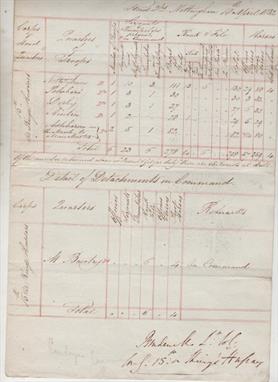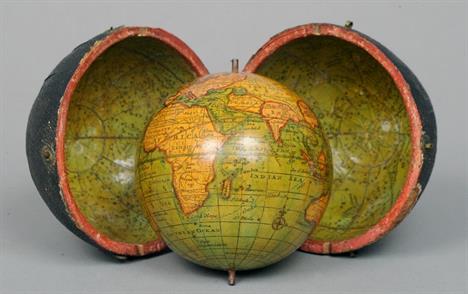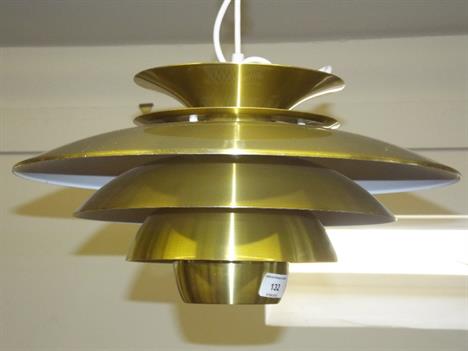534325 Preisdatenbank Los(e) gefunden, die Ihrer Suche entsprechen
534325 Lose gefunden, die zu Ihrer Suche passen. Abonnieren Sie die Preisdatenbank, um sofortigen Zugriff auf alle Dienstleistungen der Preisdatenbank zu haben.
Preisdatenbank abonnieren- Liste
- Galerie
-
534325 Los(e)/Seite
Important Lithograph of the Sikh Wars. Large scale First Sikh War Lithograph Ferozeshah (Kings Own) 1845. An impressive large scale lithograph. Originally painted by Henry Martens and published in London 10th March 1847. The Battle of Ferozeshah was fought on 21 December and 22 December 1845 between the British and the Sikhs^ at the village of Ferozeshah in Punjab. The British were led by Sir Hugh Gough and Governor-General Sir Henry Hardinge^ while the Sikhs were led by Lal Singh. The battle was one of the hardest-fought in the history of the British Army. Title on lithograph is Charge of the 3rd (Kings Own) Light Dragoons at The Battle of Ferozeshah. December 21st 1845. The whole series of these lithographs are housed in the British Library. An extremely sought after piece. Approx size 64x55 cm.
A famous letter horses for the Charge of the Light Brigade Crimean War Captain Nolan historically important autograph letter signed by the Duke of Newcastle^ at that time Secretary of War^ marked Private and dated Downing Street March 13th 1854^ addressed to Lord Stratford^ the British Ambassador in Turkey and introducing Captain Louis Nolan^ who is to buy horses : ...we have just learnt from one of your despatches that we can buy goods horses in Turkey & I therefore send out tonight Capt Nolan & a Military Vetn Surgeon to purchase at once 1000 horses & probably more eventually. Permit me to commend Capt Nolan to your good offices and valuable aid in the performance of this duty. Not time for another word... The name of Captain Nolan is legendary in the history of the Crimean War. He was the first man killed in the infamous Charge of the Light Brigade^ and his actions and subsequent death on that fateful day have themselves become the subject of considerable controversy to this day. It was Nolan who delivered the fateful order for the advance which we now know as the Charge of the Light Brigade. At the time he was blamed for delivering the order^ either by mistake or maliciously- given that more than 40% of the 600 were casualties in the pointless charge on the Russian cannons. In more recent times the blame has either been apportioned of firmly placed on Lords Raglan and Lucan. The horses which Nolan obtained via this letter would doubtless have been used in the Charge. This is regarded as one of the most famous of all the letters of the Crimean War^ and for a number of years images of it were displayed on the Crimean War Research Society. A copy of it is held in Nottingham University^ but this was damaged by fire and water in 1879. The letter comes with a further letter written in 1906 from a collector from Dunganstown Castle^ Wicklow^ to his daughter^ sending this^ with some other choice autograph letters (not present)^ in order to start her collection.
WWI the letters of a Surgeon from the front an outstanding archive of more than 300 autograph letters written in 1917 (with one from 1918) by Ambrose Edgar Woodall FRCS^ who rose to be both a Baronet and then Lord Uvedale and one of the founders of the Trades Union Hospital on Hampstead Hill a position he held until 1958. The letters have been collated and bound into a single volume bearing a portrait photograph of him on the inside cover. Loosely inserted is a small group of snapshot photographs of him taken at the Front during WWI. A highly important archive of primary source information about WWI from the pen of a working doctor and surgeon who served at the Front in France and Italy. The letters begin with his first entrance into the Army (with a Commission as Captain) with observations on fellow officers (who he doesnt much approve of) and also of the quality of his fellow doctors^ reckoning that only one in 20 are up to the job. On arrival in France he goes to a hospital at Etretat^ he discusses the role of the medical professionals both at the hospital and at the casualty clearing stations and also in the trenches^ and then describes taking charge of the funeral of a soldier who has died of consumption. He is transferred to the 46th and then the 50th Northumbrian Casualty Clearing Station where he encounters the son of the actor Bransby Williams a Captain in the BFC for 18 months doing aerial fighting and bombing raids until they found out he was under age. He then describes the shooting down of a British plane killing the observer but the pilot survived : ...they were surprised in the air & the plane was riddled with bullets before they were aware of the presence of the enemy. The pilot who escaped was suffering from shock but he had roused himself to attend the funeral of his companion who was also his particular chum. The worst of the Germans is that they are always improving this apparatus we want to be wide awake to keep pace with them... He describes a colleague trying to save the life of his brother by opening a vein to give him an instant blood transfusion only for his brother to die^ and then mentions that Lord Alfred Douglas the evil genius of Oscar Wilde is now a corporal in the ASC. He attends a lecture on shell shock (a very early example of the recognition of this condition)^ and discusses hearing the news of the Russian revolution as well as reporting on inoculating German prisoners who dont look like empire builders. By April he has about 200 patients describing them as having the intellectual level of a children of 7. He then moves to be with the Durham Light Infantry and describes a German attack with terrific bombardment followed by hand to hand fighting in the trenches and machine gun fire. Then in June he witnesses the German bombardment of a town which is no more fortified than Rochdale where he describes bodies in the streets and reports : it is this sort of thing that explains why we are all in the war. The German will profess the highest sentiments rights of humanity anything you please if by so doing he can lull you to sleep while he carries out his diabolical cruelties... Later in the month he describes the aftermath of the Battle of Messines Ridge commenting: ...it is a source of wonder to me how patiently these men bear the most frightful injuries how calmly they die... Note: a brief digest of these letters is available on request.
Opera Silk Programme 1908 fine silk programme for a gala performance at the Royal Opera House^ Covent Garden in front of Edward VII and the French President^ featuring excerpts from The Pearl Fishers^ featuring John McCormack and Faust^ featuring Dame Nellie Melba. Printed in colours on a light gold background with the Royal Coat of Arms and Edward VIIs cypher as well as the French Republic. In fine condition^ approx. 43x34cm
A pair of German World War II Third Reich Dienstglas fixed focus U-boat binoculars by Emil Busch A.G., Rathenow7 x 50 magnification, the lenses with heavy duty rubber shroud protectors, serial number 457001.Note: sold with accompanying typed note inscribed "These field glasses were given to me by my RSM Harry Claydon (Welsh Guards) when I was commanding 60th Anti-Tank Regiment (Royal Welsh Fusiliers) in Italy. He always accompanied me in my jeep and found the glasses on a dead German in a derelict tank". CONDITION REPORTS: Generally in good condition, expected wear, some slight splits to rubber lens boots and shroud covers, some chipping to paint, protective coating with some losses/perishing, screws with evidence of use, lenses seem to be in good order with some light surface scratching.
An 18th century 2 3/4 inch terrestrial pocket globe, attributed to George Adams, London The twelve engraved gores and two polar calottes hand coloured and incorporating a cartouche inscribed "A Correct Globe with the New Discoveries", contained in an original wooden shagreen covered case, the interior laid with two sets of twelve engraved celestial half gores and two polar calottes incorporating a cartouche inscribed "A Correct Globe with Ye New Constellations of Dr. Halley & Co." CONDITION REPORTS: Generally in good condition expected wear, case with some losses, some light surface scratching.
A Victorian Arts & Crafts copper waiter Dated 1894 and decorated with flowers within a wavy border; together with another decorated with interlocking birds within a scalloped rim. 19.5 cms and 21 cms diameter respectively. (2) CONDITION REPORTS: Generally in good condition, expected wear, various small dints and bruises, both could do with a light polish.
1967 Ford Mustang Fastback (LHD) Vin no. 7R02S145651 Engine no. C6ME A rousing success on street and track, the first generation Ford Mustang during 1964 – 1973 created a new class of pony car. Lee Iacocca, Vice President and General Manager of Ford Division achieved his vision of a car that would carry four people, have bucket seats, a floor mounted shifter, measure no longer than 180 inches, weigh less than 2500 pounds, and sell for less than $2500. With its long hood and short deck it proved wildly popular and remains one of Ford’s classic and most well-known vehicles. To decrease development costs, the Mustang utilised already existing components from the Falcon and Fairlane models, including the chassis, suspension and drivetrain. The body sported a shorter wheelbase, wider track, lower seating position and lower overall height. An industry first “torque box” structurally stiffened the Mustang’s construction and helped contribute to better handling. The ‘67 Mustang had a fresh look and a load of horsepower. For the first time since its launch, it faced serious competition and defended itself by creating a meaner look with more muscle. The grille opening was made larger and the rear tail light concaved; the fastback now reached all the way to the rear of the trunk. Overall size, interior and cargo space were increased, as well as a new dash and integral air conditioning. New options included the tilt-away steering wheel and fold-down rear seat on the fastback model. Standard wheel covers were a 10 ½ inch hubcap or a 21-spoke wheel cover. A new engine was added to the line-up for ‘67, the first Mustang big block, the 390ci. With redesigned front suspension and a dual hydraulic system, the car had a smoother overall ride. Rated at 320hp, the 390 used a single 600cfm Holley four-barrel carburettor with cast iron intake and manifolds. This engine, and a 4-speed manual transmission recorded quarter mile times of approximately 13 seconds and trap speeds of over 105 mph (169 km/h). A total of 28, 800 Mustangs with the 390 engine were produced. This 1967 Fastback 2+2 was produced on December 1st, 1966 in the San Jose plant. Fitted with a 390 cubic inch 320 hp 4 valve V8 engine with a 4 speed manual transmission. This engine was built by Californian Image Pty Ltd in Narangba QLD. The car is finished in Raven Black with GT livery (rocker panel red stripe and wheels) and brand new red vinyl interior. This left hand drive (LHD) vehicle is a stunning example and has not turned a wheel since its high level restoration by the current owner. This vehicle is very near to completion, with some mechanical adjustments and small cosmetic items needed. Accompanied with the vehicle a ‘Standard Report’ from Ford, import approval and a box of new extra parts. Odometer currently reading approximately 93,300 miles. Vehicle is sold unregistered.
-
534325 Los(e)/Seite



























































